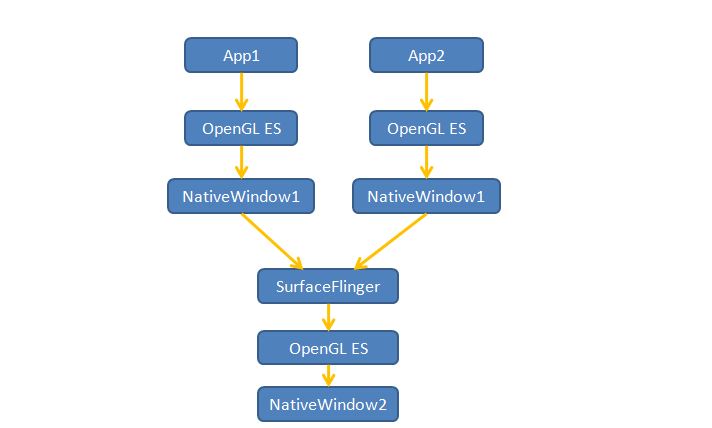- Android的本地窗口
- FramebufferNativeWindow
- Surface
前面提到android EGL库的主要作用就是将OpenGL ES和本地窗口系统结合起来。OpenGL ES就像是一个打印机,各个厂商打印机的内部实现不同(不同的OpenGL ES的实现,软件、硬件等,实现的库由EGL加载),但是只要打印的文档内容相同,按下打印键,其输出的结果都是相同的。当然打印机可以在不同种类的纸张上打印,A4,A5或者牛皮纸、塑料纸等等,打印机对这些都需要支持。OpenGL ES和打印机一样,需要兼容windows、塞班、android等多个不同的系统,所以它的实现是平台无关的,而windows、android等系统需要给OpenGL ES提供纸,这个纸就是本地窗口,而不同系统的实现肯定是不同的。打印机打印的最终内容需要呈现在纸上,对软件来说本地窗口里面肯定有buffer的存在来保存OpenGL ES画的图。
2016/03/25 注:android 4.4中已经不使用FramebufferNativeWindow了,而是使用FramebufferSurface和hwcomposer去做composer。
Android的本地窗口
上面提到,如果需要使用OpenGL ES就需要本地窗口的加入,而在前面文章中提到有两处使用OpenGL ES的地方:一是上层的3D绘图,二是SurfaceFlinger对layer的合成(先不考虑Canvas和overlay)。那么我们可以想象下面这幅图画:
我们需要两种本地窗口,一种是面对app的,一种是面对SurfaceFlinger。那么本地窗口在android中到底是什么?我们从EGL函数的调用开始,在eglCreateWindowSurface函数中,有个和平台无关的结构体为NativeWindowType,
1
2
3
4
5
6
7
EGLSurface eglCreateWindowSurface(
EGLDisplay dpy, EGLConfig config,
NativeWindowType window,
const EGLint *attrib_list)
{
return createWindowSurface(dpy, config, window, attrib_list);
}而
1
2
typedef EGLNativeWindowType
NativeWindowType;从下面的定义可以看到,在系统为android的宏下,本地窗口其实为ANativeWindow。
1
2
3
4
5
6
7
8
9
10
#elif defined(__ANDROID__) || defined(ANDROID)
struct ANativeWindow;
struct egl_native_pixmap_t;
typedef struct ANativeWindow*
EGLNativeWindowType;
typedef struct egl_native_pixmap_t*
EGLNativePixmapType;
typedef void*
EGLNativeDisplayType;
下面是ANativeWindow结构体,里面有一组函数指针,我们能够猜到,两个本地窗口都是继承了ANativeWindow,然后对函数进行赋值,“实现协议”。
1
2
3
4
5
6
7
8
9
10
11
12
13
14
15
16
17
18
19
20
21
22
23
24
25
26
27
28
29
30
31
32
33
34
35
36
37
38
39
struct ANativeWindow
{
struct android_native_base_t common;
/* flags describing some attributes of this surface or its updater */
const uint32_t flags;
/* min swap interval supported by this updated */
const int
minSwapInterval;
/* max swap interval supported by this updated */
const int
maxSwapInterval;
/* horizontal and vertical resolution in DPI */
const float xdpi;
const float ydpi;
/* Some storage reserved for the OEM's driver. */
intptr_t
oem[4];
int
(*setSwapInterval)(struct ANativeWindow* window,
int interval);
int
(*query)(const struct ANativeWindow* window,
int what, int* value);
int
(*perform)(struct ANativeWindow* window,
int operation, ... );
int
(*cancelBuffer_DEPRECATED)(struct ANativeWindow* window,
struct ANativeWindowBuffer* buffer);
int
(*dequeueBuffer)(struct ANativeWindow* window,
struct ANativeWindowBuffer** buffer, int* fenceFd);
int
(*queueBuffer)(struct ANativeWindow* window,
struct ANativeWindowBuffer* buffer, int fenceFd);
int
(*cancelBuffer)(struct ANativeWindow* window,
struct ANativeWindowBuffer* buffer, int fenceFd);
};最终找到的两个本地窗口为FramebufferNativeWindow和Surface。
FramebufferNativeWindow
SurfaceFlinger对应的本地窗口为FramebufferNativeWindow,继承了ANativeWindow,里面有个sp<NativeBuffer> buffers[MAX_NUM_FRAME_BUFFERS];,这应该就是“本地的纸”,而且还有和ANativeWindow对应的函数实现。
1
2
3
4
5
6
7
8
9
10
11
12
13
14
15
16
17
18
19
20
21
22
23
24
25
26
27
28
29
30
31
32
33
34
35
36
37
38
class FramebufferNativeWindow
: public ANativeObjectBase<
ANativeWindow,
FramebufferNativeWindow,
LightRefBase<FramebufferNativeWindow> >
{
public:
FramebufferNativeWindow();
framebuffer_device_t const * getDevice() const { return fbDev; }
bool isUpdateOnDemand() const { return mUpdateOnDemand; }
status_t setUpdateRectangle(const Rect& updateRect);
status_t compositionComplete();
void dump(String8& result);
// for debugging only
int getCurrentBufferIndex() const;
private:
friend class LightRefBase<FramebufferNativeWindow>;
~FramebufferNativeWindow(); // this class cannot be overloaded
static int setSwapInterval(ANativeWindow* window, int interval);
static int dequeueBuffer(ANativeWindow* window, ANativeWindowBuffer** buffer, int* fenceFd);
static int queueBuffer(ANativeWindow* window, ANativeWindowBuffer* buffer, int fenceFd);
static int query(const ANativeWindow* window, int what, int* value);
static int perform(ANativeWindow* window, int operation, ...);
static int dequeueBuffer_DEPRECATED(ANativeWindow* window, ANativeWindowBuffer** buffer);
static int queueBuffer_DEPRECATED(ANativeWindow* window, ANativeWindowBuffer* buffer);
static int lockBuffer_DEPRECATED(ANativeWindow* window, ANativeWindowBuffer* buffer);
framebuffer_device_t* fbDev;
alloc_device_t* grDev;
sp<NativeBuffer> buffers[MAX_NUM_FRAME_BUFFERS];
sp<NativeBuffer> front;
mutable Mutex mutex;
Condition mCondition;
int32_t mNumBuffers;
int32_t mNumFreeBuffers;
int32_t mBufferHead;
int32_t mCurrentBufferIndex;
bool mUpdateOnDemand;
};Surface
众多App对应的本地窗口为Surface,继承了ANativeWindow,类似的也有个BufferSlot mSlots[NUM_BUFFER_SLOTS];,是App的“本地的纸”,而且还有和ANativeWindow对应的函数实现。
1
2
3
4
5
6
7
8
9
10
11
12
13
14
15
16
17
18
19
20
21
22
23
24
25
26
27
28
29
30
31
32
33
34
35
36
37
38
39
40
41
42
43
44
45
46
47
48
49
50
51
52
53
54
55
56
57
58
59
60
61
62
63
64
65
66
67
68
69
70
71
72
73
74
75
76
77
78
79
80
81
82
83
84
85
86
87
88
89
90
91
92
93
94
95
96
97
98
99
100
101
102
103
104
105
106
107
108
109
110
111
112
113
114
115
116
117
118
119
120
121
122
123
124
125
126
127
128
129
130
131
132
133
134
135
136
137
138
139
140
141
142
143
144
145
146
147
148
149
150
151
152
153
154
155
156
157
158
159
160
161
162
163
164
165
166
167
168
169
170
171
172
173
174
175
176
177
178
179
180
class Surface
: public ANativeObjectBase<ANativeWindow, Surface, RefBase>
{
public:
/*
* creates a Surface from the given IGraphicBufferProducer (which concrete
* implementation is a BufferQueue).
*
* Surface is mainly state-less while it's disconnected, it can be
* viewed as a glorified IGraphicBufferProducer holder. It's therefore
* safe to create other Surfaces from the same IGraphicBufferProducer.
*
* However, once a Surface is connected, it'll prevent other Surfaces
* referring to the same IGraphicBufferProducer to become connected and
* therefore prevent them to be used as actual producers of buffers.
*
* the controlledByApp flag indicates that this Surface (producer) is
* controlled by the application. This flag is used at connect time.
*/
Surface(const sp<IGraphicBufferProducer>& bufferProducer, bool controlledByApp = false);
/* getIGraphicBufferProducer() returns the IGraphicBufferProducer this
* Surface was created with. Usually it's an error to use the
* IGraphicBufferProducer while the Surface is connected.
*/
sp<IGraphicBufferProducer> getIGraphicBufferProducer() const;
/* convenience function to check that the given surface is non NULL as
* well as its IGraphicBufferProducer */
static bool isValid(const sp<Surface>& surface) {
return surface != NULL && surface->getIGraphicBufferProducer() != NULL;
}
protected:
virtual ~Surface();
private:
// can't be copied
Surface& operator = (const Surface& rhs);
Surface(const Surface& rhs);
// ANativeWindow hooks
static int hook_cancelBuffer(ANativeWindow* window,
ANativeWindowBuffer* buffer, int fenceFd);
static int hook_dequeueBuffer(ANativeWindow* window,
ANativeWindowBuffer** buffer, int* fenceFd);
static int hook_perform(ANativeWindow* window, int operation, ...);
static int hook_query(const ANativeWindow* window, int what, int* value);
static int hook_queueBuffer(ANativeWindow* window,
ANativeWindowBuffer* buffer, int fenceFd);
static int hook_setSwapInterval(ANativeWindow* window, int interval);
static int hook_cancelBuffer_DEPRECATED(ANativeWindow* window,
ANativeWindowBuffer* buffer);
static int hook_dequeueBuffer_DEPRECATED(ANativeWindow* window,
ANativeWindowBuffer** buffer);
static int hook_lockBuffer_DEPRECATED(ANativeWindow* window,
ANativeWindowBuffer* buffer);
static int hook_queueBuffer_DEPRECATED(ANativeWindow* window,
ANativeWindowBuffer* buffer);
int dispatchConnect(va_list args);
int dispatchDisconnect(va_list args);
int dispatchSetBufferCount(va_list args);
int dispatchSetBuffersGeometry(va_list args);
int dispatchSetBuffersDimensions(va_list args);
int dispatchSetBuffersUserDimensions(va_list args);
int dispatchSetBuffersFormat(va_list args);
int dispatchSetScalingMode(va_list args);
int dispatchSetBuffersTransform(va_list args);
int dispatchSetBuffersTimestamp(va_list args);
int dispatchSetCrop(va_list args);
int dispatchSetPostTransformCrop(va_list args);
int dispatchSetUsage(va_list args);
int dispatchLock(va_list args);
int dispatchUnlockAndPost(va_list args);
protected:
virtual int dequeueBuffer(ANativeWindowBuffer** buffer, int* fenceFd);
virtual int cancelBuffer(ANativeWindowBuffer* buffer, int fenceFd);
virtual int queueBuffer(ANativeWindowBuffer* buffer, int fenceFd);
virtual int perform(int operation, va_list args);
virtual int query(int what, int* value) const;
virtual int setSwapInterval(int interval);
virtual int lockBuffer_DEPRECATED(ANativeWindowBuffer* buffer);
virtual int connect(int api);
virtual int disconnect(int api);
virtual int setBufferCount(int bufferCount);
virtual int setBuffersDimensions(int w, int h);
virtual int setBuffersUserDimensions(int w, int h);
virtual int setBuffersFormat(int format);
virtual int setScalingMode(int mode);
virtual int setBuffersTransform(int transform);
virtual int setBuffersTimestamp(int64_t timestamp);
virtual int setCrop(Rect const* rect);
virtual int setUsage(uint32_t reqUsage);
public:
virtual int lock(ANativeWindow_Buffer* outBuffer, ARect* inOutDirtyBounds);
virtual int unlockAndPost();
protected:
enum { NUM_BUFFER_SLOTS = BufferQueue::NUM_BUFFER_SLOTS };
enum { DEFAULT_FORMAT = PIXEL_FORMAT_RGBA_8888 };
private:
void freeAllBuffers();
int getSlotFromBufferLocked(android_native_buffer_t* buffer) const;
struct BufferSlot {
sp<GraphicBuffer> buffer;
Region dirtyRegion;
};
// mSurfaceTexture is the interface to the surface texture server. All
// operations on the surface texture client ultimately translate into
// interactions with the server using this interface.
// TODO: rename to mBufferProducer
sp<IGraphicBufferProducer> mGraphicBufferProducer;
// mSlots stores the buffers that have been allocated for each buffer slot.
// It is initialized to null pointers, and gets filled in with the result of
// IGraphicBufferProducer::requestBuffer when the client dequeues a buffer from a
// slot that has not yet been used. The buffer allocated to a slot will also
// be replaced if the requested buffer usage or geometry differs from that
// of the buffer allocated to a slot.
BufferSlot mSlots[NUM_BUFFER_SLOTS];
// mReqWidth is the buffer width that will be requested at the next dequeue
// operation. It is initialized to 1.
uint32_t mReqWidth;
// mReqHeight is the buffer height that will be requested at the next
// dequeue operation. It is initialized to 1.
uint32_t mReqHeight;
// mReqFormat is the buffer pixel format that will be requested at the next
// deuque operation. It is initialized to PIXEL_FORMAT_RGBA_8888.
uint32_t mReqFormat;
// mReqUsage is the set of buffer usage flags that will be requested
// at the next deuque operation. It is initialized to 0.
uint32_t mReqUsage;
// mTimestamp is the timestamp that will be used for the next buffer queue
// operation. It defaults to NATIVE_WINDOW_TIMESTAMP_AUTO, which means that
// a timestamp is auto-generated when queueBuffer is called.
int64_t mTimestamp;
// mCrop is the crop rectangle that will be used for the next buffer
// that gets queued. It is set by calling setCrop.
Rect mCrop;
// mScalingMode is the scaling mode that will be used for the next
// buffers that get queued. It is set by calling setScalingMode.
int mScalingMode;
// mTransform is the transform identifier that will be used for the next
// buffer that gets queued. It is set by calling setTransform.
uint32_t mTransform;
// mDefaultWidth is default width of the buffers, regardless of the
// native_window_set_buffers_dimensions call.
uint32_t mDefaultWidth;
// mDefaultHeight is default height of the buffers, regardless of the
// native_window_set_buffers_dimensions call.
uint32_t mDefaultHeight;
// mUserWidth, if non-zero, is an application-specified override
// of mDefaultWidth.
This is lower priority than the width set by
// native_window_set_buffers_dimensions.
uint32_t mUserWidth;
// mUserHeight, if non-zero, is an application-specified override
// of mDefaultHeight.
This is lower priority than the height set
// by native_window_set_buffers_dimensions.
uint32_t mUserHeight;
// mTransformHint is the transform probably applied to buffers of this
// window. this is only a hint, actual transform may differ.
uint32_t mTransformHint;
// mProducerControlledByApp whether this buffer producer is controlled
// by the application
bool mProducerControlledByApp;
// mSwapIntervalZero set if we should drop buffers at queue() time to
// achieve an asynchronous swap interval
bool mSwapIntervalZero;
// mConsumerRunningBehind whether the consumer is running more than
// one buffer behind the producer.
mutable bool mConsumerRunningBehind;
// mMutex is the mutex used to prevent concurrent access to the member
// variables of Surface objects. It must be locked whenever the
// member variables are accessed.
mutable Mutex mMutex;
// must be used from the lock/unlock thread
sp<GraphicBuffer>
mLockedBuffer;
sp<GraphicBuffer>
mPostedBuffer;
bool
mConnectedToCpu;
// must be accessed from lock/unlock thread only
Region mDirtyRegion;
};最后
以上就是单薄项链最近收集整理的关于android graphic(2)—EGL和OpenGL ES Android的本地窗口 FramebufferNativeWindow Surface 的全部内容,更多相关android内容请搜索靠谱客的其他文章。









发表评论 取消回复